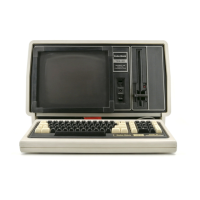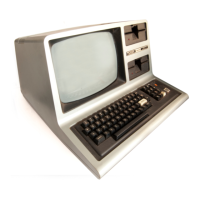Line
I
is the
RAS*
output. As you can see,
it is
a
direct
function of
MREQ from the
CPU.
Z72, pins 4 and
5,
is
RAS*'s
buffer.
Line J,
MUX
is
sourced at Z69, pin
9,
through
buffer
Z72, pins 2 and 3.
Line
K,
CAS*, is
buffer-
ed by
Z72, pins 10
and
9,
and
is
a
function of QCAS, at
Z70, pin 6.
Notice the
following
sequence of events:
RAS* goes low
first.
MUX then
changes states.
CAS* then changes states
one clock
cycle later.
First, we get RAM address
select,
then MUX,
then we get
Column Select.
Hence,
the
first
part of the
address
we give the
RAMs will be the row
address.
We'll then flip
the switch
(multiplexer) and follow
with the
column address.
RAM ADDRESSING
In about the middle
of sheet
1,
on the left side
of the
RAM array,
multiplexers Z35 and
Z51
are
shown. On the
left side of
Z35, we find the area
where four address
lines
are
coming in. One
brace of four is
labeled
"0"
and
the
other
is labeled
"1
". Z51 is configured the same way
except
there
are only three
lines per brace.
The tells us that when
the
select pin is low,
the multiplexer will be
outputting data
associated with these
input lines. The
"1"
tells us the
opposite is
true. When the
select
pin
on the
multiplexer
goes high, it
will be outputting data
associated with the
"1"
input
address lines. The
select input for both
multiplexers
is pin 1. Z35,
therefore, operates
somewhat like a
4-pole,
double
throw switch,
where the select input (pin
1
)
is doing
the switching.
Z51 is used only as a
3-pole, double throw
switch
—
one
input/output is not
used. The enable input
to
the
multiplexer is pin 15. Since pin 15
is grounded on
both
IC's, the
"switches" are
always enabled.
READING
FROM
RAM
Assume the
CPU
needs
RAM data. Let's follow the
address-
ing and data
paths the
RAM will use. We'll use a 4K
RAM
example.
The
CPU outputs a
MREQ
and a
RD. The address
decoder
outputs
MEM*
and
RAM*.
MEM* activates the
RAM/ROM
data buffers
and
RAM* enables the chip select
(CS) for the
RAMs. At the
same time, the multiplexer
will load the
address into the
RAMs. RAS*
goes
low. The
MUX signal
is
low
at this time, so
A0 through A5 on the
RAM receive the
low
order address.
Notice that
RAS*
is buffered
by
Z68,
pins 14
and
13,
and is
applied
to
pin 4 of all the
RAMs. The
negative
going signal at pin 4
will load the lower
order
address in the
row section of each
RAM. A short time
later,
MUX changes state; it
goes high. The
multiplexer, Z35 and
Z51,
now switch and
the high order addresses
are applied to
the
RAMs. CAS*
will
now go
low.
CAS*
is
applied to
buffer Z67,
pin 14.
Pin 13
of
Z67 passes CAS* to pin 15
of
all
eight RAMs. On
the negative
transition of CAS*, the
high order
addresses (A6 through
A1
1)
will be
loaded in the
column
section of each
RAM. The
RAMs now
have the
entire address
from the
CPU. The RAM will now
output
data through the
buffers and
to the
CPU.
WRITING
TO RAM
The
difference between
a write
operation and a
read
opera-
tion is
exactly two
signals. Address
decoding
and address
multiplexing
work the same
way. During a
data
write, how-
ever, the
CPU
sends
data to the
RAMs. Hence, the
ROM/
RAM buffers are not
needed;
and
MEM* will not go
low.
Instead
of the
CPU issuing a
RD command,
it
supplies a
WR
instruction. WR*
is tied to
all eight
RAMs on pin
3.
When
this pin is
low, data
will be stored in
RAM
at
the
specified address.
When this
pin is high,
the
RAMs are in
read cycle.
REFRESHING
THE
RAMS
The TRS-80
uses
dynamic type
RAM. A
dynamic
RAM dif-
fers slightly
from a
static
RAM in data
retention.
A static
RAM will retain data
stored
in it so long
as power
is
applied
to it. A
dynamic
RAM
must be
periodically
addressed to
ensure
that it
retains the data
loaded
into it.
The
periodic
addressing is
called
refreshing.
You might
compare a
dyna-
mic
RAM with an
air-filled tire
with a slow
leak.
Every once
in a
while, the
tire must
be shot a
little
air so it won't go
flat.
If
we
did not
service
that tire, it
would
finally become
unusable.
The same
is true
about
dynamic RAM.
If the
system
does not
access the
RAMs every
so often,
they
will
"forget" data.
The
dynamic
RAM in
the TRS-80
uses an
"RAS Only"
type of
refresh.
In other words,
when RAS*
goes low, the
RAMs in the
system
will "refresh
themselves"
even
though
the
RAM
may
not be
in use at the
time.
A
s
stated before,
RAS
*
is gen
erated by
the
CPU
at pin
19
(MREQ). When-
ever
MREQ
goes
low,
RAS* goes
low; and the
RAMs
will
load
the lower
order address
into the row
section.
The
CPU
may be looking
at
system
ROM when
MREQ
goes
low,
but
RAM
will still
receive
RAS* and hence
be
"refreshed."
Normally, you
would not
be
too
concerned
about
this
aspect
of the
RAMs. But
you need to
be aware of the
dif-
ferences
between a
static
RAM and
a
dynamic
RAM.
Remember:
Dynamic
RAM must be
periodically
addressed
to
enable it to
retain data.
In the
TRS-80, the
RAM should
be refreshed
once
every two
milliseconds.
RAM
PROGRAMMING
You may
have
noticed X71
during the
discussion of the
RAM. X71
is a
DIP shunt.
It is used to
program the
size of
memory in a
system.
Find pin 13 on the
RAM.
Following
pin
13 down,
you
will see it is tied
to two
pins of
DIP
shunt X71.
Pin 13 of the
RAM is the
CE
(Chip
Enable) or
the A6
address input.
In a 4K
system, pins 4
and 13
of X71
12

